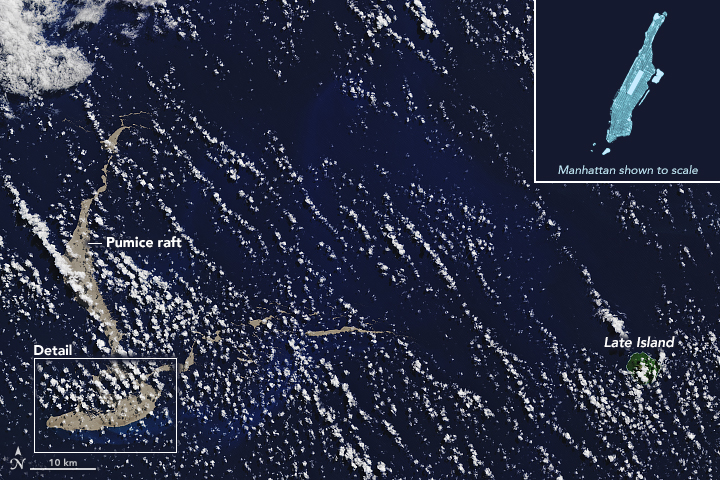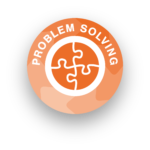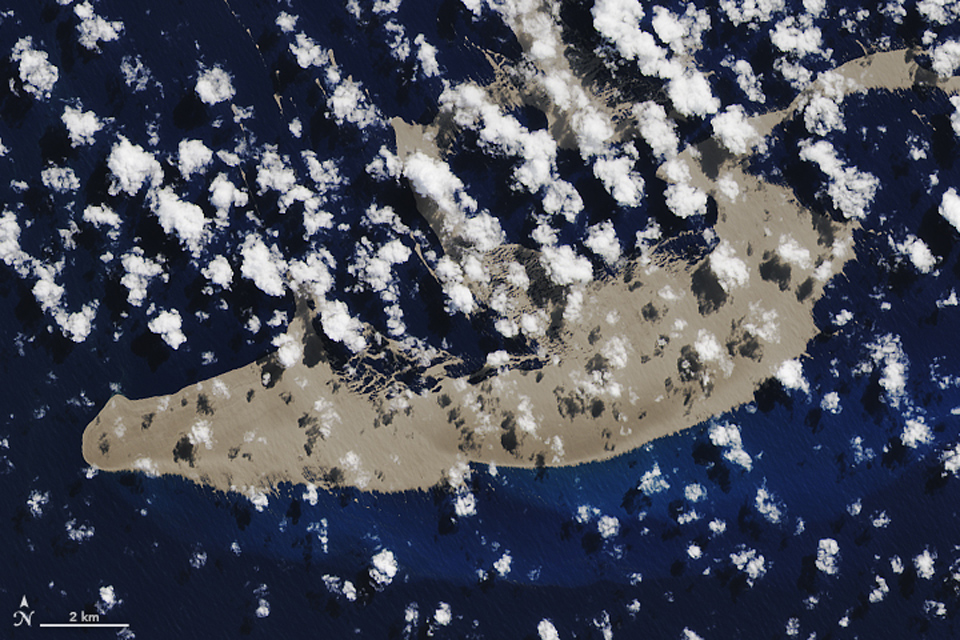Are you a teacher, home-educator or actively involved parent or guardian of a youngster with High Learning Potential (HLP)? Then you know the importance of finding unusual topics that inspire thinking in many different directions. The natural phenomenon of “pumice rafts” is perfect for this!
Give the following descriptive text to your student(s) to discuss – or read it to them, targeting one or more of the curriculum areas or questions at the end as appropriate to their age and needs. See also ‘Further Resources’ below and the video link.

Pumice Raft off Tonga August 2019 Image from Nasa’s Earth Observatory (https://earthobservatory.nasa.gov/images/145490/a-raft-of-rock)
What is a Pumice Raft?
In August 2019, an enormous “pumice island” appeared in the tropical Pacific Ocean near Late Island in the Kingdom of Tonga. Pumice is probably best known as the grey, scratchy lump beside the bath at home that is used to rub hard skin off tired feet…but this pumice mass was the size of 20,000 football fields!
Boats in the remote waters were sailing as usual when suddenly, instead of splashing waves, there was the weird sound of scratchy rock. “It was like ploughing through a field at least 6 inches thick”, said an eye-witness. Some pumice stones were even the size of basketballs! Sailors reported the smell of sulphur and described navigating through thick pumice “for six to eight hours, much of the time [with] no visible water”.
Lieutenant Tim Oscar of the Royal Australian Navy described it as “the weirdest thing I’ve seen in 18 years at sea”, adding “The rock looked to be sitting two feet above the surface of the waves and lit up a brilliant white colour in the (ship’s) spotlight. It looked exactly like the edge of an ice shelf.” Officers on a Royal New Zealand Air Force ship saw the rock raft southwest of Raoul Island and estimated it to measure an incredible 300 miles (482 km) long by 30 miles (48 km) wide. Amazing images were captured by the Operational Land Imager on Landsat 8 for NASA, the US National Aeronautics and Space Administration.
Pumice is formed when volcanic lava cools rapidly. This leads scientists to believe a submarine volcano erupted, possibly the Monowai seamount or a series of smaller eruptions on the Kermadic Ridge, such as the Havre seamount. When lava cools, depressurises and hardens, the gas trapped creates the pores that make pumice float to create these amazing rafts.
Some High Learning Potential students can be prone to anxiety but they should not be alarmed! Similar pumice islands emerge across the globe every 5 years or so and can drift for weeks or even years before they fully disperse. Also, recent thinking is that pumice floats have played an important role in the evolution of life on Earth, ferrying animals, plants, sea organisms and even colonies of microbes across long stretches of ocean. Furthermore, pumice rafts may well encourage the growth of new coral reef due to the algae, organisms and fresh corals that get on board!
20 Questions and Learning Ideas
- What is pumice?
- Why can you find it in most homes and bathrooms?
- What is it used for in the building industry and horticulture?
Arts/Humanities
- Using what you have learned above as a starting point, create one or more of the following:
- a factual, newspaper report
- a piece of descriptive writing
- part of a creative story
- an adventure story about an animal or organism transported to a new ‘home’
- What is the origin of the word ‘pumice’? Investigate the Latin.
- What is the word for pumice in French? German? What does this tell you?
- Write a piece of music that sounds like your boat journey through smooth waves and then scratchy pumice
- Create a dance, short play or piece of artwork that tells the story of suddenly finding yourself caught in a pumice raft
- Find the Pacific Ocean on a map. Compare the size of the pumice raft to a country you know!
- Draw a map of the Pacific Ocean including Tonga, Australia, New Zealand – and the pumice island! Include the Monowai and Havre seamounts and Kermadic Ridge.
- Research historical occurrences of continents being joined or divided by moving land masses.
STEM
- How and when was this pumice raft formed? Is it floating or fixed to the ocean floor?
- What percentage of pumice appears above water? Compare this to an iceberg. What scientific principles govern these ratios?
- Add Maths calculations to the map you may have drawn earlier (above) to ensure all your landmarks are carefully to scale.
- Investigate the different satellites and imaging devices that spotted and continue to monitor this drifting pumice.
- What sea life might benefit from volcanic eruptions and how?
- What suggests this drifting pumice could actually help the Great Barrier Reef?
- Why could sailors smell sulphur?
- Researchers observed “the erupted pumice means this volcano erupts magma high in silica like rhyolite”. -Can you explain this?
- What equipment might be used or could you invent to predict the next submarine volcanic event and pumice raft?
Further Resources:
- About the August 2019 event at https://www.bbc.co.uk/news/world-australia-49469446 including video footage
- Also at https://sciencythoughts.blogspot.com/2012/08/pumice-raft-linked-to-havre-seamount.html and https://earthobservatory.nasa.gov/images/145490/a-raft-of-rock
- Pumice rafts in general at https://en.wikipedia.org/wiki/Pumice_raft
- Coral reef implications at https://www.news.com.au/technology/environment/natural-wonders/giant-pumice-raft-could-restore-great-barrier-reef/news-story/21dbcdc75832d69ee0dd86306b3a9914
- A complementary global and environmental educators’ blog entry at https://potentialplusuk.org/index.php/2019/02/04/explore-your-world/









